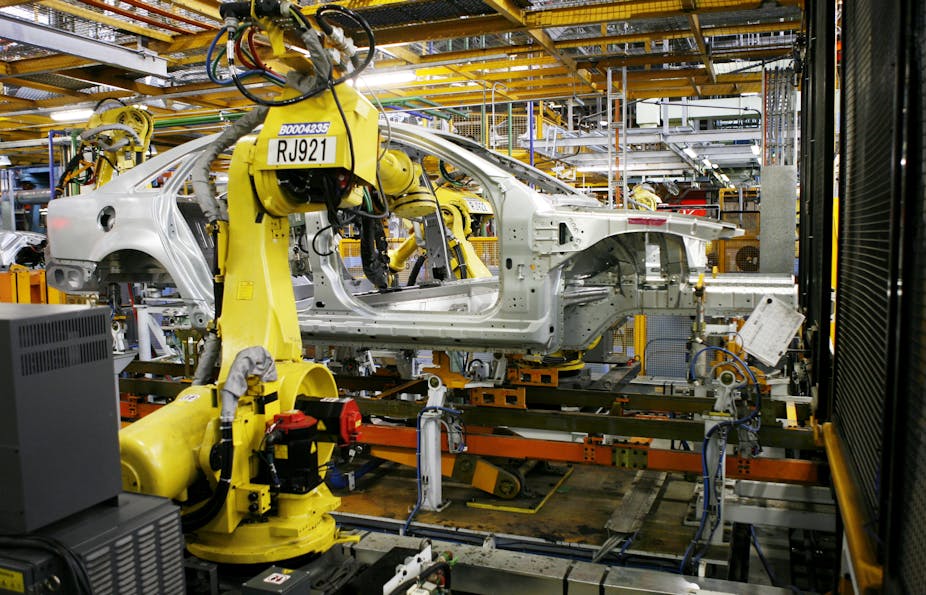It is no coincidence the federal government is increasing its existing multi-billion dollar subsidies to the car industry at the same time it is increasing the tax burden on the mining sector.
Price signals from global markets are telling Australian labour and capital to reallocate resources out of manufacturing industries characterised by excess supply and into commodities, where there is excess demand. Politicians do not like the distributional implications of these price signals, particularly when it comes to manufacturing.
The manufacturing share of developed economies has been in decline for decades. But that does not mean that manufacturing output has been declining in an absolute sense. Far from it. In the United States and the United Kingdom, manufacturing output was at record levels prior to the onset of the financial crisis. Manufacturing employment has fared less well, but this is symptomatic of substantial long-term productivity gains in this sector, not declining absolute levels of output.
Manufacturing has also been declining steadily as a share of world GDP. This should not be surprising. It is driven by much the same process that saw a decline in the agricultural share of GDP during the 19th and 20th centuries with the onset of industrialisation. As incomes grew, the share of food and other agricultural goods in consumption and production declined. The same is now happening with manufactured goods, as a greater of share of rising incomes is allocated to services.
Unfortunately, the political class the world over still associates manufacturing with economic development and progress. In the minds of many politicians, primary industries are associated with economic backwardness. Service industries and employment are often viewed as inferior to manufacturing, not least because they do not have the tangible outputs that politicians and others can readily understand. The intangible outputs of service industries also do not lend themselves to the photo opportunity with the politician in the hardhat and fluro-vest.
It is a mindset exemplified by Kevin Rudd’s statement, before he became prime minister, that he wanted Australia to have “a bigger vision for its economic future than being China’s quarry and Japan’s beach”. Apart from the implicit xenophobia, these comments reflect a profound misunderstanding of the sources of value creation and progress in the Australian economy.
Contrary to popular stereotypes, Australia’s primary industries are at the forefront of technology and innovation, employing highly skilled workers who are also highly productive. These industries compete in global markets with little or no government assistance, especially by international standards.
However, like the US and other high-income economies, most of the value-added in the Australian economy is attributable to service industries. This is symptomatic of an advanced stage of economic development. But politicians still yearn for manufacturing. As opposition leader Tony Abbott told workers at the Repco distribution centre in Ingleburn last year, “I want us to be a country that continues to make things”.
What also sets manufacturing apart in the minds of politicians is that manufacturing employment is often more geographically concentrated than primary and tertiary employment. This concentration translates into electoral influence and gives manufacturers the kind of leverage over politicians that ultimately results in the shake-down of Australian taxpayers by foreign car-makers.
The antiquated thinking that leads politicians to associate manufacturing with economic success helps explain why many governments around the world provide assistance to their manufacturing sectors. This is a cost they impose on their economies and a benefit they unwittingly bestow on the foreign consumers of their exports. It also helps explain why the prices of manufacturing goods have been in steady decline. The flip-side of Australia’s terms of trade boom is the slump in the terms of trade experienced by manufacturing economies such as Japan and South Korea.
The excess capacity in global manufacturing is partly due to strategic industry and trade policies followed in many countries. This is a vicious circle, because the more manufactured goods prices decline, the louder the demands for additional assistance from producers.
Bolting things together is something any country can do if it is willing to misallocate sufficient resources for this dubious privilege. For example, Australia designs and manufactures its own submarines, which sounds impressive, until you consider the enormous cost to taxpayers relative to buying off-the-shelf from abroad. This DIY approach to defence procurement has probably done more to harm Australia’s national security than enhance it.
The Gillard Government’s mercantilist notion that we should subsidise and protect the local car industry because other countries do so belies its rhetoric on free trade at international fora like the G20. Industry Minister Kim Carr issues press releases celebrating the profitability of US carmakers in Australia, neglecting to mention that those profits were secured at the expense of Australian consumers and taxpayers. It is hard to imagine similar government press releases celebrating the local profits of foreign miners or banks.
Industry policies such as the Australian government’s assistance to the car industry impoverish many for the benefit of a few. They turn Australia into a rent-seeking rather than a productive society.

